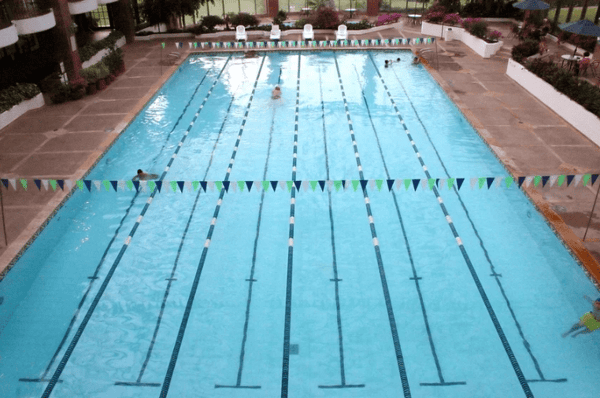We have to do a lot to take care of our swimming pools. We have to brush. This helps keep algae spores from taking a foothold on our pool’s surface. We have to net out and vacuum dirt and debris. Anything organic can turn into what are known as phosphates. Phosphates are food for algae. They can be harmless if our water chemistry is on point and we are properly circulating the water, but if you were to get an algae bloom, we don’t want a Las Vegas buffet laid out for it. We have to make sure our filters are clean. We have to make sure our equipment is working properly and there are no leaks, creaks or squeaks. Probably the most important is testing the water often and adding the proper chemicals to balance it. There are many fields to test for. Sanitizer, pH, alkalinity, calcium hardness, phosphates, and cyanuric acid. Cyanuric acid is also known as stabilizer or conditioner.

What is a Pool Stabilizer?
Pool stabilizer, aka CYA, is the chemical compound of (CNOH)3. It has a role as a xenobiotic. It is also a member of 1,3,5-triazines and a heteroaryl hydroxy compound. Finally, it is a tautomer of an isocyanuric acid. What does all this gibberish mean? Not stuff we really need to concern ourselves with when dealing with pool stabilizer. Cyanuric acid acts like a sunscreen for our chlorine. It prevents it from burning off in a matter of hours if we didn’t have enough present in the pool.
Healthy Ranges of Pool Stabilizer
It is recommended in a traditionally chlorinated pool to have the cyanuric acid between 30-50 ppm. For salt chlorinated pools it is 50-60 ppm. Why is it higher? Because salt pools don’t get the weekly addition of pool stabilizer from floating tablets.
How Does Pool Stabilizer Get into My Pool?
There are many ways to build a pool stabilizer reserve in a swimming pool. Adding instant or granular conditioner is one way. You usually do this with new water or if the levels are below the recommended ranges. Other products contain pool stabilizer such as trichlor tablets, trichlor granular and dichlor granular. These products will gradually increase your CYA level.
Why Keep Pool Stabilizer Low?
It is suggested to keep your pool stabilizer levels low. This is because high levels can cause problems with your chlorine. The higher the level, the harder the chlorine has to work, which renders it less effective. Because it is less effective, if we have a high pool stabilizer level we have to keep our chlorine reserve higher. This results in extra chemicals and extra money. No bueno! For example, if you had a cyanuric acid level of 127 ppm, you would need to keep your chlorine between 6-8 ppm. Now what would we do if the health department came for a surprise visit? They are not pool operators. They don’t understand the logistics of pool stabilizer and the need to keep the chlorine higher. They might shut your body of water down because of “high chlorine levels”.
Low levels of pool stabilizers are ideal for having your chlorine be most effective and stay in the water longer. It is less work, money and time for us. I recommend testing your water often to see the levels of your CYA. The Pool Shark H2O app when paired with the LaMotte Spin Lab gives you your pool stabilizer levels among several other fields in just 60 seconds! The results are sent to any device you have the Pool Shark H2O App on. You can also manually test all your levels with a reagent test kit and manually enter them into the Pool Shark H2O App. This innovative App uses the Langelier Saturation Index to ensure your water is not corrosive or scale forming, but as close to neutral as possible.
How to Lower Pool Stabilizer Levels
Ahhh, here comes the bad news part. Pool stabilizer does not evaporate. The only way it would get lower is by removing some water or from splash out. There is research showing Aluminum Sulfate aka Floc, can help reduce CYA levels, but the studies are still in their infancy. Reverse osmosis is another way to remove not just pool stabilizer, but ALL chemicals from your pool water. This is a green way to do it, but it does cost a pretty penny. You are better off draining some or all of your pool water depending on the age of the water. Pool water should be completely drained every five years, or when certain levels such as pool stabilizer, total dissolved solids and calcium hardness get too high. Being smart and keeping low pool stabilizer levels is the best way to operate. See you poolside!
More Commercial Pool Chemistry Resources
Free, vs Combined vs Total Chlorine - A Guide for Commercial or Public Pool Operators
Chlorine Shock vs Non-Chlorine Swimming Pool Shock
Why Being Able to Calculate the Volume of a Commercial or Public Swimming Pool is Important
Cyanuric Acid Levels in Swimming Pools
Ideal Alkalinity in Commercial Pools
Managing pH and Alkalinity in Pools
Commercial Pool Chlorine Management
Cyanuric Acid in Your Pool Too High? How to Remove Cyanuric Acid (Lower Pool Stabilizer)
Lowering Alkalinity in Swimming Pools
Reasons Your Public or Commercial Pool Water Could Be Cloudy
Muriatic Acid in Swimming Pools
How to Lower pH in Pools, Water Parks and Water Features
Does Chlorine Kill Poop in a Swimming Pool?
Total Dissolved Solids: When Should I Drain My Pool?
Why Pool Chemical Storage Cabinets are Important for Commercial Pools
Storing Pool Chemicals: What Commercial Pool Operators Need to Know



